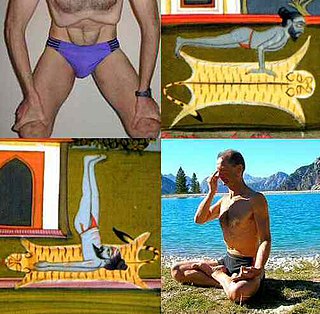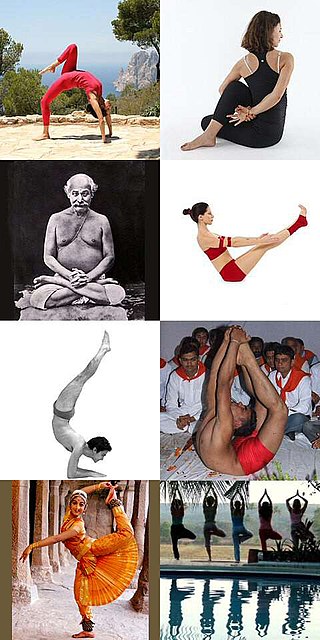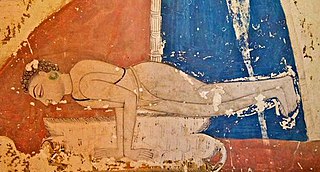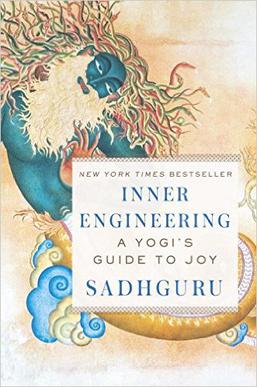
Liber AL vel Legis, commonly known as The Book of the Law, is the central sacred text of Thelema. Aleister Crowley said that it was dictated to him by a beyond-human being who called himself 'Aiwass'. Rose Edith Kelly, Crowley's wife, wrote two phrases in the manuscript. The three chapters of the book are spoken by the deities Nuit, Hadit, and Ra-Hoor-Khuit.

Hatha yoga is a branch of yoga that uses physical techniques to try to preserve and channel vital force or energy. The Sanskrit word हठ haṭha literally means "force", alluding to a system of physical techniques. Some hatha yoga style techniques can be traced back at least to the 1st-century CE, in texts such as the Hindu Sanskrit epics and Buddhism's Pali canon. The oldest dated text so far found to describe hatha yoga, the 11th-century Amṛtasiddhi, comes from a tantric Buddhist milieu. The oldest texts to use the terminology of hatha are also Vajrayana Buddhist. Hindu hatha yoga texts appear from the 11th century onward.

An āsana is a body posture, originally and still a general term for a sitting meditation pose, and later extended in hatha yoga and modern yoga as exercise, to any type of position, adding reclining, standing, inverted, twisting, and balancing poses. The Yoga Sutras of Patanjali define "asana" as "[a position that] is steady and comfortable". Patanjali mentions the ability to sit for extended periods as one of the eight limbs of his system. Asanas are also called yoga poses or yoga postures in English.

The Yoga Sutras of Patañjali is a collection of Sanskrit sutras (aphorisms) on the theory and practice of yoga – 195 sutras and 196 sutras. The Yoga Sutras was compiled in the early centuries CE, by the sage Patanjali in India who synthesized and organized knowledge about yoga from much older traditions.
In Sanskrit texts, Rāja yoga was both the goal of yoga and a method to attain it. The term also became a modern name for the practice of yoga in the 19th-century when Swami Vivekananda gave his interpretation of the Yoga Sutras of Patanjali in his book Raja Yoga. Since then, Rāja yoga has variously been called aṣṭāṅga yoga, royal yoga, royal union, sahaja marg, and classical yoga.

Pranayama is the yogic practice of focusing on breath. In yoga, breath is associated with prana, thus, pranayama is a means to elevate the prana-shakti, or life energies. Pranayama is described in Hindu texts such as the Bhagavad Gita and the Yoga Sutras of Patanjali. Later in Hatha yoga texts, it meant the complete suspension of breathing. The pranayama practices in modern yoga as exercise are unlike those of the Hatha yoga tradition.

Kriya Yoga is a yoga system which consists of a number of levels of pranayama, mantra, and mudra, intended to rapidly accelerate spiritual development and engender a profound state of tranquility and God-communion. It is described by its practitioners as an ancient yoga system revived in modern times by Lahiri Mahasaya, who claimed to be initiated by a guru, Mahavatar Babaji, circa 1861 in the Himalayas. Kriya Yoga was brought to international awareness by Paramahansa Yogananda's book Autobiography of a Yogi and through Yogananda's introductions of the practice to the West from 1920.

The Garuda Purana is one of 18 Mahāpurāṇa texts in Hinduism. It is a part of the Vaishnavism literature corpus, primarily centering around the Hindu god Vishnu. It was composed in Sanskrit and is today also available in various languages like Gujarati and English. The earliest version of the text may have been composed in the first millennium CE, but it was likely expanded and changed over a long period of time.

Gheranda Samhita is a Sanskrit text of Yoga in Hinduism. It is one of the three classic texts of hatha yoga, and one of the most encyclopedic treatises in yoga. Fourteen manuscripts of the text are known, which were discovered in a region stretching from Bengal to Rajasthan. The first critical edition was published in 1933 by Adyar Library, and the second critical edition was published in 1978 by Digambarji and Ghote. Some of the Sanskrit manuscripts contain ungrammatical and incoherent verses, and some cite older Sanskrit texts.
Within Thelema, the Great Work is the spiritual endeavor aimed at realizing one's True Will and achieving a profound mystical union with the All. This path, crafted by Aleister Crowley, draws inspiration from Hermetic alchemy and the Hermetic Qabalah. The cornerstone of Thelema is the Book of the Law, received by Crowley in 1904 through a communication with the entity Aiwass. This text became the central scripture, heralding a new Aeon for humanity and outlining the principles of Thelema.

Magick, Liber ABA, Book 4 is a book by 20th-century occultist Aleister Crowley. It is widely considered to be his magnum opus.

In ceremonial magic, a magical formula or a word of power is a word that is believed to have specific supernatural effects. They are words whose meaning illustrates principles and degrees of understanding that are often difficult to relay using other forms of speech or writing. It is a concise means to communicate very abstract information through the medium of a word or phrase.

The Complete Illustrated Book of Yoga is a bestselling 1960 book by Swami Vishnudevananda, the founder of the Sivananda Yoga Vedanta Centres. It is an introduction to Hatha yoga, describing the Yoga Sutras of Patanjali and the Hatha Yoga Pradipika. It contributed to the incorporation of Surya Namaskar into yoga as exercise. While some of its subject matter is the traditional philosophy of yoga, its detailed photographs of Vishnudevananda performing the asanas is modern, helping to market the Sivananda yoga brand to a global audience.
The Yoga Yajnavalkya is a classical Hindu yoga text in the Sanskrit language. The text is written in the form of a male-female dialogue between the sage Yajnavalkya and Gargi. The text consists of 12 chapters and contains 504 verses.

The Darshana Upanishad is one of the minor Upanishads of Hinduism written in Sanskrit. It is one of twenty Yoga Upanishads in the four Vedas, and it is attached to the Samaveda.

The Trishikhibrahmana Upanishad, also known as Trisikhibrahmanopanisad, is one of the minor Upanishads of Hinduism and a Sanskrit text. It is attached to the Shukla Yajurveda and is classified as one of the 20 Yoga Upanishads.

Inner Engineering: A Yogi's Guide to Joy is a 2016 book written by Indian yogi and mystic Sadhguru. The book was featured among The New York Times Best Seller in the spirituality and self help category for November 2016. The book is intended to be a spiritual guide with practices for personal growth, and also a look at the author's own spiritual journey.
Sharngadhara-paddhati is an anthology of Sanskrit-language short poems (subhashita) from India. It was compiled by Sharngadhara in 1363.

Yoga Makaranda, meaning "Essence of Yoga", is a 1934 book on hatha yoga by the influential pioneer of yoga as exercise, Tirumalai Krishnamacharya. Most of the text is a description of 42 asanas accompanied by 95 photographs of Krishnamacharya and his students executing the poses. There is a brief account of practices other than asanas, which form just one of the eight limbs of classical yoga, that Krishnamacharya "did not instruct his students to practice".

Ashtanga yoga is Patanjali's classification of classical yoga, as set out in his Yoga Sutras. He defined the eight limbs as yamas (abstinences), niyama (observances), asana (posture), pranayama (breathing), pratyahara (withdrawal), dharana (concentration), dhyana (meditation) and samadhi (absorption).
















